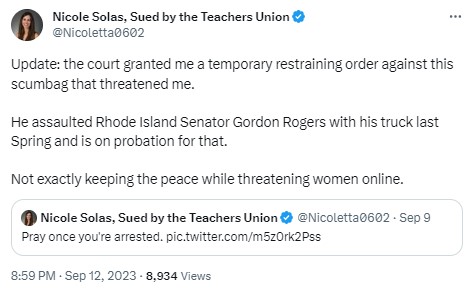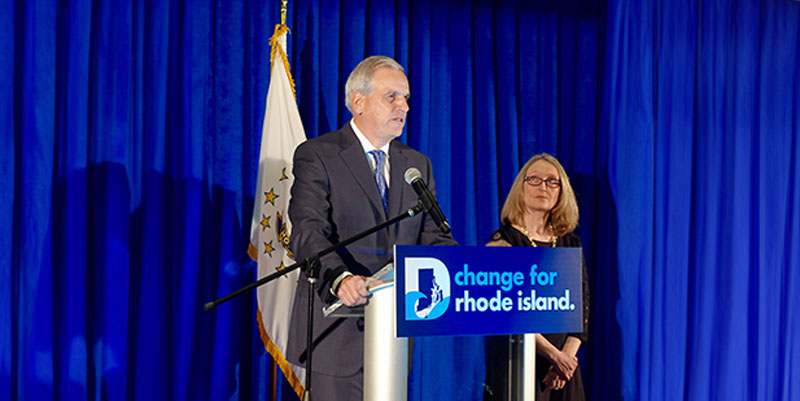Yesterday, through the ministrations of U.S. District Attorney Zachary Cunha under Attorney General Merrick Garland, the Biden administration pressured Rhode Island’s Washington Trust bank into a multimillion-dollar settlement and imposed a big PR hit over alleged racism in its lending practices. Journalists are faithfully transcribing the “redlining” narrative they’ve been handed, which means our state is not having the important discussions needed on this topic. The racist lending is supposedly “proven” through statistics and disparate outcomes based on race and neighborhood, but nobody seems interested in details.
To my eye, the key detail is the banks the Biden Administration considers to be “peer lenders,” which are supposedly less racist than Washington Trust. As far as I can tell from the settlement, “peer” is defined as receiving no fewer than half Washington Trust’s number of home mortgage loan applications and no more than twice that number. That sounds like regional banks, but presumably, it could also include niche lenders specifically serving minority neighborhoods or the small online lenders that seem to proliferate.
In other words, a few online banks somewhere in the country could be lifting the average to a degree a specific brick-and-mortar bank in Rhode Island shouldn’t be expected to achieve, all things considered. A serious study (and a serious judicial investigation) would provide a table of all of the “peer lenders,” not just compare one bank to the group average. If there are just a handful of banks in the pool, and if some are focused on serving this particular community, then it’s possible that a majority of the “peers” could be just as “racist” as Washington Trust, but when grouped with a few with very high percentages of lending in these neighborhoods, the average goes up.
If this is the case, then the district attorney could investigate other banks, and Washington Trust would be among the “peer lenders” group with a better average. With millions of dollars and deep, sensitive social divisions on the line, basing accusations on statistical outcomes, we should expect a more substantive analysis than might be required for a project in an undergrad course. Along similar lines, notice that in all the detailed maps in the DA’s exhibits, not a single one shows detail from another bank. It is as if the prosecutors know that nobody is ever going to demand that it actually prove a case.
Unfortunately, our local news media is unlikely to pursue a narrative (which I’d bet is the truth) in which a local Rhode Island institution is being shaken down by a cynical Democrat administration looking for political talking points to shore up one of its key dependent constituencies.
Even more, none of this touches the broader question of whether every bank needs to solicit applications from minority areas. The existence of peer lenders that are receiving the applications suggests that residents are able to find lenders, and I’ve seen no argument that mortgages from Washington Trust are especially beneficial. Social and economic costs are associated with the federal government’s shaking down American businesses in order to foster racial grievance headlines, and we should be having a public debate whether the benefits (if there are any) are worth it.
Featured image modified from Shutterstock.
[Open full post]From the time he first entered politics in a serious way, we’ve been warned that Donald Trump represented a unique threat that would destroy our country. This has provided an important lens for evaluating the events that have followed.
For instance, during and after the 2020 election, many of us have questioned the narrative that, “Donald Trump will impose (or would have imposed) dark fascism to our country… but we’re totally not doing anything beyond the usual fair-is-fair rules of elections to elect a visibly deteriorating career politician who was notably corrupt and dishonest even when he was healthy.”
Now, it’s “We will never have a real election or any freedom again if Donald Trump is reelected… but all of these many prosecutions of him (consisting of novel theories and charges that typically don’t result in legal action) are totally not political persecutions, but the straightforward application of the law by the books.”
His detractors seem to think the prosecutions are landing as if they were evidence of the claim of Trump’s unique threat, but I don’t think that’s the picture most Americans think they’re seeing.
[Open full post]The story has moved on since I made a note to highlight this, but it remains an important point, particularly because suggested by a Republican:
Mayor Kenneth Hopkins is on the defense after three City Council members voiced strong concerns about the city potentially using its $6-million share of Gov. Dan McKee’s “Learn365RI” money to buy the iconic − and financially struggling − Park Theatre.
The notion that McKee should be fishing for positive headlines around the state by pretending more government funding of recreational activities will somehow improve education is bad enough. The idea that the money can be spent on government takeover of deteriorating privately owned properties for some unspecified reason — while arguably completely in keeping with the governor’s true motivation — is beyond the pale.
Whether Hopkins was just freelancing with this idea or had a tacit wink and nod from the governor’s office before the media spotlight hit his window, Rhode Islanders should make it clear that the impulse toward waste and corruption has to stop. (We should also recognize the value of splitting government between the parties to a significant degree.)
[Open full post]One hesitates to make too much of an activist article like Steve Ahlquist’s August 9 report and transcription of a conversation with a Woonsocket city worker. However, two observations are worth making, considering Progressives’ ascendance in Rhode Island and beyond.
The first relates to the underlying issue. The city has installed armrests in the middle of some park benches, and activists are complaining that they’re “anti-homeless architecture,” as Ahlquist’s headline puts it. By intent or otherwise, the armrests make it difficult for homeless people to lie down on the benches, which Progressives find to be an assault on their rights.
Just so do they disregard the rights of the broader public, who ought to be able to set standards for the character of public spaces. Ahlquist and others may obstinately dispute the point, but the presence of homeless people changes the aesthetic of a space, not to mention raising legitimate concerns about health and safety. One needn’t pass moral judgement on them to observe that the conditions and recent histories of the homeless tend to correspond with concerning behaviors and mental health challenges (at least those of the bench-sleeping subcategory) and speak to the condition of the surrounding society.
Indeed, as Ahlquist notes, a man’s dead body was found on one of these benches in the winter. Helping people in these circumstances is an important concern (for which the Progressives and I would offer different solutions), but taking measures to prevent their dying on park benches is a reasonable step for their safety and for the public good.
The second point has to do with the light Ahlquist shines on the city worker. For the moment, anyway, Progressives still claim to take the side of the workers of the world, although that may have more to do with the fact that labor unions’ core value is actually the financial and political support of the Wokers of the world, rather than honest labor.
Yet, note what happens when a worker’s job leads him to take a position Ahlquist doesn’t like. Somebody has been removing these armrests, and the policy having been created at a higher level of authority, this man’s job is to maintain and replace them. In Progressive eyes, this makes him an enforcer of unjust power. He’s no longer within the fold but becomes part of the wicked power structure.
The job of a public worker, that is, must be to implement and enforce the Progressive ideology in whatever form it might take on a given day. This conclusion is no surprise. In all things, from media hypocrisy to the different standards of justice being applied to Americans based on their political beliefs to the ability to enjoy God-given freedoms enshrined in the Constitution, the decisive criteria is agreement with them, and everybody must choose between cooperation and common sense, on one side, and fealty to the Woke, on the other.
Featured image by Justin Katz on Adobe Firefly.
[Open full post]Social media provide a strange, unprecedented venue for public interactions. On one hand, these platforms promise the degree of connectivity and access that has characterized the Internet from its early popularization. On the other hand, a bit of space between our raw personalities and our in-print public personas is healthy.
So, what to make of the fact that Rhode Island Attorney General Peter Neronha has “muted” me on Twitter, and with pitiful excuse? One is tempted to say that people show their true colors in such places, but who could survive the immediate codification of his or her extemporaneous responses in casual conversation?
The quick summary is that Neronha posted, without link or context, that he mutes “troll accounts.” He and I had a bit of back-and-forth about public officials’ preventing the public from interacting with them evenly on social media. When I pressed for the criteria for his muting people, he simply asserted that I was “beyond the bounds,” and that was it.
Honestly, my first reaction is that this impetuous immaturity on his part is illustrative of disqualifying inadequacies that ought to keep him from further public office. If I were to file a legal complaint, related to government transparency or otherwise, and it came before him, I wouldn’t trust his office to handle it fairly. I was hardly harassing him on his Twitter account, so if my mild behavior put me beyond the pale of his awareness on social media, then how could anybody who shares my views, generally, be confident we’re not beyond the pale of his responsibilities in office?
The fair counterbalance I’ll offer is that I don’t expect the attorney general to hand me his cell phone number, give me the passcode to his home security, or invite me along to all of his professional or political meetings. After all, he didn’t block me, as (say) WPRI reporter Ted Nesi did after I asked whether a politician’s doing him a favor in his role as a journalism professor might create a conflict, so I can still heckle Neronha from the sidelines if I so choose; he just doesn’t have to hear me.
Still, Rhode Islanders must be able to trust the AG to conduct himself with a fairness well beyond the standards of a thin-skinned journalist. If I’d actually been trolling Neronha, by any reasonable definition, then muting would be a measured response. But the question nags: why was it such a bother to him that I wanted to know the standards for defining a Rhode Islander as a “troll”? His reaction makes one wonder how easily we lowly citizens might be dehumanized and deprived of our rights in his estimation.
The most frightening thought that follows is that he might be the best of them (meaning Rhode Island Democrats), which suggests principles of due process may not carry much weight in the Ocean State.
ADDENDUM (September 27, 2023, 7:14 a.m.
Having apparently read this post, Attorney General Neronha responded on Twitter to a direct question of mine from September 12, stating that he hadn’t muted me. Providing no facial expressions or body language, social media presents a new category of challenges. Of course, we act with nearly as little information as we have when attempting to interpret people’s thoughts behind their skulls. After all, one receives no notification of having been muted or unmuted, and others can choose to see individual posts of people they’ve muted. In any event, I’m glad Mr. Neronha has not crossed the line I thought he’d crossed (or, in any event, stepped back across it in the other direction).
Featured image from Shutterstock, with background adjusted using AI.
[Open full post]Is the idea to consolidate as much power as possible — both incorporating all areas of society and expanding across geographies — and then put it in the hands of the incompetent and corrupt? That sure seems to be what’s happening at every level of government.
[Open full post]Among the many reasons for growing distrust of mainstream journalism is its apparently incessant need to make everything an indication of impending doom. (This is true, at least, when mass hysteria is seen to serve Democrats, as with the climate. On matters that point in the other political direction, like illegal immigration and the economy, only good news, if it can be found, squeezes through the guard.)
So, we get articles like Alex Kuffner’s in the Providence Journal, confirming that, “Yes, downpours are getting heavier, and more frequent in RI.” The article purports to supply the numbers to substantiate this claim, although the cited source does not appear to make them readily available to the public. One gets the sense, anyway, that the reader is meant simply to acknowledge that numbers are given and accept that they support the claim being stated on their basis without giving them much thought. Consider this paragraph from Kuffner:
Since 1905, the average number of days per year in the Providence area with more than 1 inch of rain has increased from eight to 14, according to the Northeast Regional Climate Center at Cornell University. Last year, there were 12 such days. This year, there have been 10 so far.
If the average (over some unspecified time period) is 14 and last year saw 12, it may be that the curve is headed down. In any event, water is life, and if we can get our acts together, surely we can benefit from this flow of life rather than cowering from it.
[Open full post]Excellent work by Jim Hummel of the Hummel Report with this investigative report, published on the front page of yesterday’s Providence Journal, pertaining to a state mandate that 25% of its vehicles be electric; i.e., zero emission.
The goal was to make one quarter of the state’s light duty vehicle fleet EV’s by 2025. So already excluded from that calculation is all of the state’s medium and heavy duty vehicles – plow trucks, dump trucks, etc. Seems like a reasonable, even modest, goal.
Apparently not. From Hummel’s investigative report:
The state has struggled to reach zero-emission goals for its own fleet of vehicles, as cost, supply and unwillingness by some departments to purchase all-electric and hybrid vehicles have left Rhode Island significantly short of hitting its initial target.
Accordingly,
McKee quietly issued a new executive order in May giving the state five more years to reach the 25% goal, although the administration insists it wasn’t moving the goalposts
Interesting. So it turns out that it isn’t just the private sector who finds electric cars costly and impractical. In fact, it came to light a couple of weeks ago that even US Energy Secretary Granholm couldn’t make one work for a summer road trip without a staffer in a fossil fuel vehicle acting as an advance team at the next charging station(s).
No criticism of McKee here. The initiative that mandated the state’s fleet be 25% EV, called “Lead by Example” (gosh, its name is sure turning out to be inadvertently prescient), is not Governor McKee’s but his predecessor’s, Governor Gina Raimondo, via an Executive Order that she signed in 2015.
The push from certain isolated quarters to change from fossil fueled to electric vehicles is a huge proposition and one that is fraught with … um, challenges, to put it mildly. As we are seeing in real time, you cannot ignore the reality of those challenges and make it happen by rigid, blind order – even a modest one.
In pushing the goal back, Governor McKee simply took action that is grounded in reality; in stark contrast with the basis of Governor Raimondo’s 2015 Executive Order.
The fact that a state government, with all of its power and resources, could not achieve even a 25% change-over to electric vehicles in a ten year timeframe speaks volumes about the practicality of the proposal.
Rhode Island via the Department of Environmental Management will soon hold hearings on new “clean air” regulations, Advanced Clean Cars II (ACCII) and Advanced Clean Trucks (ACT), that would effectively phase out the sale of all new fossil fuel cars and 75% of fossil fuel trucks in Rhode Island by 2035.
Nowhere in the draft regulation does it guarantee that manufacturers will have adequate inventory to supply the state. Nowhere in the draft regulation does it explain how Rhode Islander consumers and businesses will be able to pay for an EV, notoriously more expensive than fossil fueled ones.
In short, the draft ACCII and ACT regulation has no more grounding in reality than Governor Raimondo’s 2015 “Lead by Example”.
The infrastructure, production and affordability of electric vehicles is nowhere close to real world applicability. Issuance of another government mandate based in fantasy is not going to bring that about, as we are seeing play out in real time with the prior governor’s Executive Order.
[Open full post]Two implications of this recent tweet from Nicole Solas illustrate the danger that begins to fester when the institutions of a state become wholly partisan.

The first implication is that it will be very surprising if the attorney general or anybody else in Rhode Island law enforcement turns up the heat on a Democrat threatening a blacklisted conservative.
The second is, if anything, more disturbing. As somebody on the upper end of paying attention to happenings in Rhode Island, I’m surprised that I didn’t know about an assault on a sitting state senator that resulted in a probation. Searches on both Google and Bing produce zero results and, in fact, point instead to the incident in which Rogers knocked out an intruder in his home.
We’re not getting the news, in Rhode Island, and we therefore cannot be said to be making informed decisions during elections. Deepening the peculiarity is that controversies should be of interest to our fading news media. It’s like they’d rather destroy their business model then question the Party.
[Open full post]On WNRI 1380 AM/95.1 FM, John DePetro and Justin Katz discuss:
- Providence schools continue to fail and nobody asks the right questions
- Magaziner jumps right into the partisan spokesman role
- Leonard lets the election pass him by (without a base)
- Illegal immigration simmers at the edge of mainstream awareness
- Curious incuriosity in the media about mail ballots
Featured image by Justin Katz using Firefly.
[Open full post]





